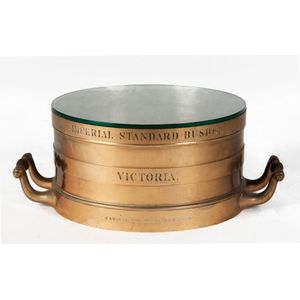
Antique Mahogany Dip Circle for Measuring Magnetic Field Angle
English, circa 1900 a mahogany cased dip circle on stand, circa 1900, a precision scientific instrument for measuring the angle between the horizon and the Earth's magnetic field; mark of maker, W & J George Ltd, Birmingham, England, to base plate, 11.02…

19th Century English Pocket Compasses
Two pocket compasses, English, mid 19th century, one brass Troughton & Simms, London; gun metal, F Cox, Newgate street, London, largest measuring 2.95 in. diameter

Etched Ivory Ruler Set - 11 Pieces
A collection of ivory etched rulers and calibration instruments, comprising of eleven pieces, the largest measuring 7.87 in.

Siemens Universal Galvanometer with Fitted Box and Accessories
A late 19th century Siemens Universal galvanometer, in original mahogany fitted box with matching numbered box, certificate and instrument, multiple brass fittings and extras, the booklet details 'this instrument combines in itself the arrangements necessa

NZ Govt Imperial Yard Measure (1863)
New Zealand Government brass Imperial Yard measure 1863

NZ Govt 1870 Imperial Troy oz 300 Measure by De Grave
New Zealand Government Imperial Troy oz 300 measure 1870, made by De Grave short & Son, London

1860 NZ Govt 2 Gallon Bronze Peck Measure
New Zealand Government bronze Imperial peck measure 1860, 2 Gallons

1863 Imperial Yard Measure in Oak Box
New Zealand Government brass Imperial yard measure 1863 fitted in original oak carry box

Vintage Calculator Set with Accessories
Fuller's spiral slide rule Calculator, by W. F. Stanley, London, in wooden case, together with a barograph, a Hockley Abbey John Rabone & Sons tape measure and a metronome (4), length 16.93 in. Provenance: The Estate of Neville Grace, Sydney

19th Century Imperial Standard Brass Measures
Set of three Imperial Standard measures, Bushel, Half Bushel and Peck, solid case brass, 19th century Set of three Imperial Standard measures, Bushel, Half Bushel and Peck, solid cast brass, 19th century engraved 'Victoria, J. McEwan & Co. London and Melbo

Victorian Government's Imperial Standard Volume Measures
Set of 7 Victorian Government measures of capacity from Old Melbourne Observatory circa 1940. Gallon, half gallon, quart, pint, half pint, gill & half gill. In one box with glass strike discs. Each brass measure is hand engraved 'Imperial Standard, Victori

Brass Imperial Bushell Measure with Glass Top
A large brass two handle grain measure, inscribed 'Imperial Standard Bushell Victoria', fitted with a glass top, 10.04 in. high, 18.70 in. diameter

Silverware and Cocktail Set
A Carrington cocktail shaker, together with silver plate measures, spill vases and a pair of deep dishes

Late 19th Century Pewter Measures Set
Four various pewter measures, late 19th century

Irish Pewter Gill Measures
19th century two pewter Irish measures, baluster shaped, gill and half gill capacity

Assorted 18th-19th Century Pewter Measures (6)
A collection of assorted pewter measures, 18th to 19th century various sizes and shapes, (6)

Assorted 18th-19th Century Pewter Measures (7)
A collection of assorted pewter measures, 18th to 19th century various sizes and shapes, (7)

Georgian Pewter Measure Collection
A collection of four Georgian pewter measures

Victorian Irish Pewter Haystack Measures by Austen & Son, Cork
Set of three graduating Victorian Irish pewter haystack measures marked for Austen & Son, Cork

19th Century Copper Cone-Shaped Measures
Two 19th century copper conical shaped measures